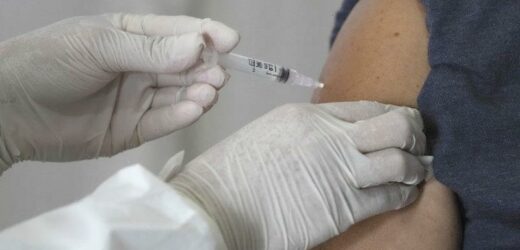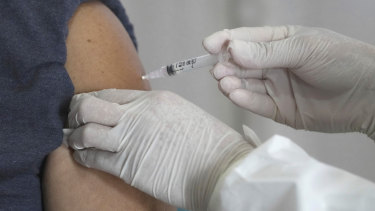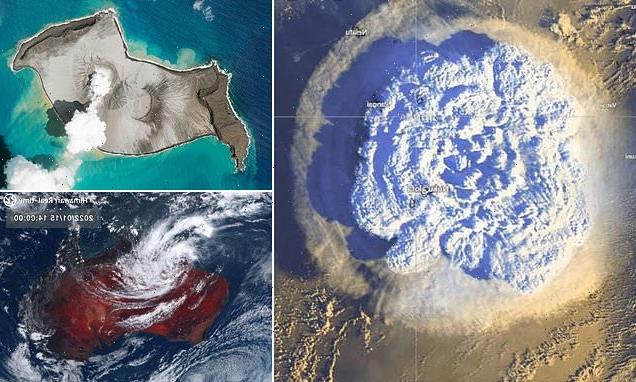For our free coronavirus pandemic coverage, learn more here.
A leading economist is expecting the nation to recover strongly this year led by a rebound in NSW and the Northern Territory despite the latest COVID-19 outbreak slowing the overall pace of financial growth.
Deloitte Access Economics’ Business Outlook forecasts the national economy to grow 3.6 per cent in 2022, with NSW to surge 5.2 per cent and the Northern Territory by 6.9 per cent. The Queensland and West Australian economies are each forecast to grow 3 per cent, with Victoria up 2.8 per cent.
Booster shots are expected to help keep the economic recovery going.Credit:AP/Tatan Syuflana
Deloitte partner Chris Richardson said these forecasts assume “a bunch of pain” due to the Omicron variant outbreak across Australia. His expectations are less bullish than the Reserve Bank’s outlook, which were released before the Omicron outbreak. The RBA forecasts 4 per cent GDP growth to the June quarter 2022 and 5.5 per cent to December.
“The world is far better prepared for this than it was two years ago. So while this is a hurdle in our recovery, it won’t be a complete roadblock,” Mr Richardson said, adding the expected growth rate is still above average.
“Australia is now much more match-fit for fighting COVID: we’re well vaccinated, we’ve got the hang of juggling lockdowns and other COVID challenges, and we’re cashed up with dollars left over from when the pandemic meant that money couldn’t be readily spent. That combination spells resilience and recovery,” he said.
NSW is tipped to be particularly strong due to the state remaining open despite the latest case surge, while the Northern Territory is a commodity-driven recovery. Mr Richardson said Victorians are the “best in the nation” at juggling COVID.
He said the biggest risk continues to be the virus and its variants and the best investment would be to help poorer nations get vaccinated.
His forecast assumes booster rates continue to rise, helping keep COVID-related deaths low, improving treatments for the virus, a rise in migrant and tourist numbers and limited lockdowns. The report also provides an allowance for half of the workforce to spend a week unable to work, either due to illness or needing to isolate, over the first half of the year.
Over 2022, he expects household spending to rise 6.4 per cent and business investment by 5.2 per cent. Unemployment is expected to fall to 4.2 per cent, down from 4.6 per cent, and wage growth is tipped to surpass inflation next year.
“Beyond the obvious health implications, the new variant raises the spectre of renewed state border restrictions, quarantine requirements and maybe even lockdowns. That generates the potential for investment-killing uncertainty for businesses,” he said.
Treasurer Josh Frydenberg said the report confirmed the nation’s economic fundamentals “remain strong” with a solid outlook on GDP growth and the jobs market.
“Deloitte reminds us that we are still in a pandemic and that COVID-19 will continue to pose a threat to
Australia’s economic recovery,” he said.
Labor’s Treasury spokesman Jim Chalmers criticised the pace of the recovery, saying it would be stronger if the pandemic had been better managed, including more rapid tests and a faster booster roll out.
“The same complacency and incompetence that’s given Australians a shortage of groceries and rapid tests has given workers a shortage of wages growth for almost a decade,” he said.
Bank of Queensland’s chief economist Peter Munckton has forecast strong first quarter growth of 1.5 to 2 per cent provided there is not another widespread lockdown.
“The economy started the year with substantial momentum,” he said, “and the general economy has become increasingly good at adjusting to the impact of COVID.”
But he said how much the virus will impact the economy for the rest of the year is “unknown” as it’s unclear whether there will be more variants and their severity. The main issue outside of a variant, he said, is balancing strong demand with supply.
“These supply problems should largely ease over the next month as cases decline, government regulations evolve and more people get booster shots,” he said.
The Morning Edition newsletter is our guide to the day’s most important and interesting stories, analysis and insights. Sign up here.
Most Viewed in Politics
From our partners
Source: Read Full Article



